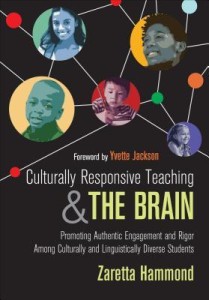Culturally Responsive Teaching & the Brain: Promoting Authentic Engagement and Rigor Among Culturally and Linguistically Diverse Students
Author: Zaretta Hammond
Published: December 1, 2014 by Corwin
I’ve read about a dozen professional development texts about culturally responsive teaching because I am very committed to this pedagogical concept. I particularly liked this text because it offered a new angle. Zaretta Hammond weaves neuroscience with both traditional and contemporary ideas of culturally responsive teaching. She doesn’t just say how we can practice this pedagogy, but she tells what is happening in students’ brains when we do and do not use culturally responsive practices. Hammond provides an excellent layout for her ideas, and if anything, I would even love for some of the chapters and ideas to be expanded further. That said, her work connects well with other scholarship, so I would likely use this text in an education class and pair it with another more traditional text about the subject, such as Geneva Gay’s landmark Culturally Responsive Teaching: Theory, Research, and Practice.
I was fortunate enough to read this text with preservice teachers enrolled in a Multicultural Education class. While I have much experience with the ideas taught in this class, I am taking the course as a doctoral student with the intention of integrating the ideas into future courses I might teach. Therefore, from my discussions with peers, I have gotten an insider perspective of this text and how it might work in a classroom. They have enjoyed it very much. It is not a long text (falling just under 200 pages), but the ideas promote fantastic classroom discussions. Our discussion boards have been brimming with students’ thoughts, and there is no shortage of topics to discuss. I include a few topics I’ve discussed below.
As stated previously, Hammond discusses some of the main ideas featured in other culturally responsive texts. She argues that culturally responsive pedagogy is a mindset–not an easy list of tips or tools. However, she does provide many strategies, such as how to make our classrooms visually engaging and responsive to students. Instead of stock posters of MLK, Jr., she argues that teachers might include framed art from different cultures. I liked this idea a lot and agree that it is more culturally responsive. She also discusses the differences between cultures, such as oral versus written traditions and the role these play on student learning. She addresses myths, such as those about poverty and access and colorblindness.
A few chapters into the book, Hammond begins to introduce neuroscience and marries these concepts with culturally responsive practices. For instance, she describes the ways an individual’s brain reacts with the student feels fearful versus feeling accepted. This reminded me a bit of my 7th grade science class. I had a teacher who was quite cruel to me and very strict, overall. I don’t think I learned very much in that class because my brain felt a bit frozen. Then I think about all of the wonderful teachers I’ve had who were very open and accepting. I think I learned twice as much in these classrooms, and it shows the value of creating responsive rapport with students.
I could write pages upon pages about this book. It would be a disservice for me to summarize some of her sections, such as how the neurons in your brain fire, create new pathways, and connect to culture or the ways individualistic and collectivist positionings differ or how microaggressions impact students. So instead of summarizing and commenting on the whole book, I will recommend that you read it. It is excellent. The text offers ideas that are quite different from others I’ve seen about the topic. Hammond fills a gap in research that needed to be filled, and I look forward to reading other publications by her.
Which culturally responsive texts are your favorite?


I want to read this one. I haven’t read nearly enough in this area. One that I appreciated is Culturally and Linguistically Responsive Teaching and Learning by Sharokky Hollie. Another is Other People’s Children by Lisa Delpit.
Yes! I’ve read Delpit and liked it a lot. Geneva Gay’s book is fantastic. I have heard of Hollie’s book, but I haven’t read it. Thanks for the recommendation!